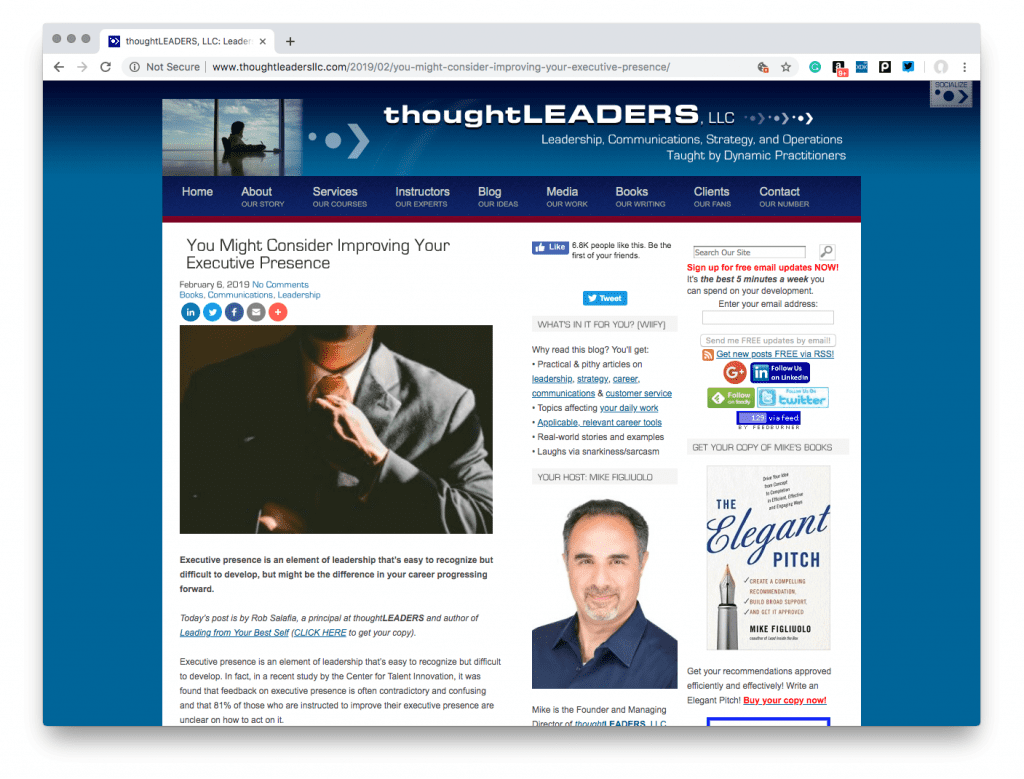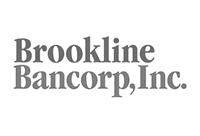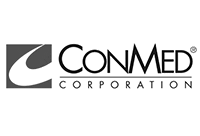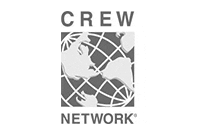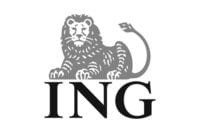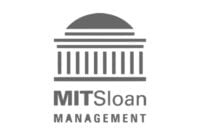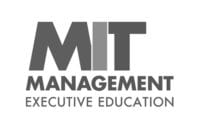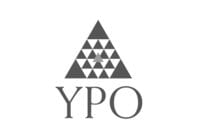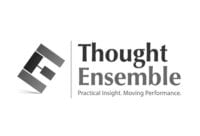Executive presence is an element of leadership that’s easy to recognize but difficult to develop, but might be the difference in your career progressing forward.
Today’s post is by Rob Salafia, a principal at thoughtLEADERS and author of Leading from Your Best Self (CLICK HERE to get your copy).
Executive presence is an element of leadership that’s easy to recognize but difficult to develop. In fact, in a recent study by the Center for Talent Innovation, it was found that feedback on executive presence is often contradictory and confusing and that 81% of those who are instructed to improve their executive presence are unclear on how to act on it.
For instance, can you relate to any of the situations below?
You have been passed up for a promotion—even though your record demonstrates that you’re smart enough and capable enough. No one can put a finger on exactly what the issue is, but it’s enough to hold you back.
Your boss or someone higher on the food chain has mentioned to you that, “you might consider improving your executive presence.” You walk away thinking to yourself, ok, now what?
You’re a manager with a team member who you know has the capability to shine but is struggling to find their voice.
Having spent the last 20 years helping executives develop executive presence, I have found the process to be something that people (regardless of gender, industry, country, and culture) struggle to understand and develop.
Why is developing executive presence important?
It’s simple. Externally, we are evaluated by how well we show up and navigate the work environment and culture. Those in charge of making promotion decisions need to confidently answer questions such as “Do we see this person as promotable?”, “Do others listen to his or her ideas?”, and “Will this person be a good fit on the team and be able to influence the decision-making process?”
By cultivating executive presence, we not only improve how others experience us, but enhance our capacity to lead a more fulfilling and purposeful life.
Layers of Experience
Think of executive presence as how we show up in relation to others. Our practice of developing our executive presence can grow if we think about it in layers of experience. Consider the following:
How others experience us.
How others experience themselves when they are with us.
The story others tell about us when we are gone.
As we start to develop and expand our presence, we begin to notice the impact that it has on others. When we put out attention to this impact, we learn to expand into the experience of others. Our growth as a leader and effective communicator arises out of this awareness.
Transitions
How often have you had one of those days where you found yourself going from meeting, to meeting, to meeting, to meeting? Were you able to mentally “reset”, or did you find yourself distracted in the next meeting—or longer? Our days at work are filled with transitions. We are always moving from one thought to another, one space to another, one meeting to another. While getting caught up in the momentum of the day might seem innocuous, or just plain unavoidable, transitions offer a prime opportunity for us to develop our executive presence.
For instance, I once coached a young man, Brent, who was bright, energetic, and full of ideas. His one big issue was that he operated at lightning speed.
One morning, after we had worked together for a month or so, I was sitting in a conference room waiting for Brent to show up for our session. Suddenly the door flew open, and all I could see was a streak as Brent sailed past me and landed in a chair across the table. In my mind I imagined papers flying up into the air like you see in the cartoons. I was startled.
If I were Brent’s superior or coworker, our meeting would be compromised from the start. How could I trust that he was fully prepared for our meeting? I certainly wouldn’t experience him as possessing executive presence. So I smiled, looked at Brent in the eyes, and asked him if he would be willing to stand up, go back outside, close the door, and put into practice the routine that we had been working on.
The sequence goes like this—Breathe-Connect-Land—and is one that you can put into practice immediately as well. Arrive at the door of your meeting, pause, get still, and take a deep breath. Grab the handle and connect with the purpose of the meeting. As you breathe out, land inside of yourself for a brief moment with a feeling of confidence. Then, enter into the new space.
As soon as Brent stepped into the room, he paused took another breath and connected and landed with me. My whole experience of him changed. He had a larger sense about him, and his presence increased. He seemed much more confident, open, and ready for our conversation.
Consider your own daily transitions. What kind of an impression do you think you make in your office?
How do you think people experience you? What words come to mind?
Energetically? — Do you show up frenetically like Brent in the story above?
Emotionally? — Are you poised under pressure, or do you react quickly and explode?
Physically? — Do you step forward and fill the space or retreat and disappear?
Relationally? — Are you distant and aloof or confident and approachable?
Intellectually? — Are you generous and curious or intellectually stingy or superior?
How do others likely experience themselves when are with you?
Do they feel large or small? Valued or insignificant?
What story might others tell about you when you’re gone?
If we consider executive presence as how we show up in relationship with others, we take the first steps in closing the gap between the perception we have of ourselves and the perception that others have of us. The best way to improve is to reach out to a number of people with whom you interact on a daily basis and ask them their candid answer to the three questions above.

Rob Salafia is an authority on executive presence and transformative learning experiences. He is the author of the new book, Leading From Your Best Self: Develop Executive Poise, Presence, and Influence to Maximize Your Potential (CLICK HERE to get your copy), on which this post is based. Rob is a Principal at thoughtLEADERS, LLC, where he teaches our Compelling Executive Presence course. a Lecturer and Executive Coach at MIT Sloan School of Management.
